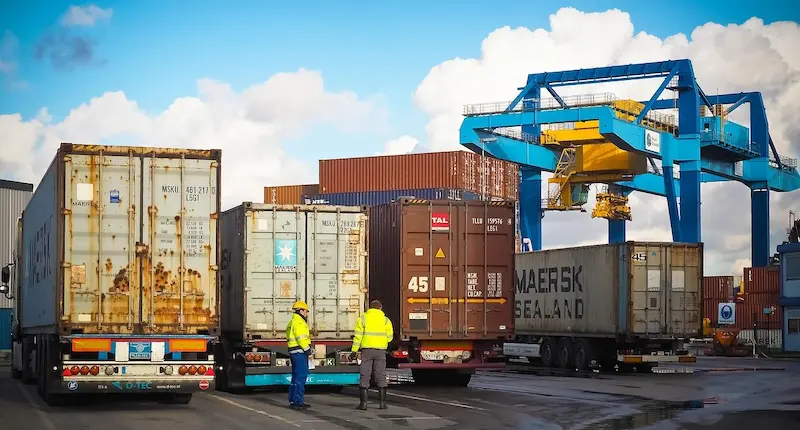Container Port Throughput Trends in July 2025
Global container traffic witnessed a year-on-year rise of 4.1% in July 2025, according to the most recent data from the Global Container Port Throughput Index. This index tracks monthly container throughput across more than 340 ports worldwide, covering over 80% of the global volume.
While the annual growth paints a bright picture, the figures also reveal a slight 1.1% decline month-on-month from June, hinting at early signs of a market cool-down following a busy first half of the year.
Yearly Growth Vs Monthly Shifts
| Métrica | July 2025 Data | Notas |
|---|---|---|
| Crescimento Anual | +4.1% | Compared to July 2024 |
| Month-on-Month Change | -1.1% | Compared to June 2025 |
Regional Performances Highlight Varied Dynamics
O Middle East and South Asia regions led the charge with a robust 7.8% increase in throughput year-to-date, reflecting a strong surge in container traffic sustained through much of the year. Not far behind, Europa recorded impressive volume gains of 6.5% year-to-date, signaling healthy growth despite some global economic jitters.
On the flip side, the Greater China market reflected a slower pace overall. Though throughput held steady at a 2.0% increase annually, it dropped 3.4% from June to July, with a 12-month average growth of 5.6%, lying slightly beneath the global average of 6.1%.
Key Greater China Ports – July 2025 Changes
- Xangai: Down 1.8% month-on-month and 4.6% year-on-year
- Ningbo: Fell 4.1% month-on-month but up 6.7% year-on-year
- Shenzhen: Rose 4.1% month-on-month but down 1.1% year-on-year
Other Regional Highlights: North America and Southeast Asia
North and Southeast Asia saw mixed outcomes — the index for North and Southeast Asia ports slipped by 3.0% month-on-month but was still up 3.7% year-on-year. The rolling 12-month average growth rate decreased to 5.3%, suggesting some moderation.
However, individual Southeast Asian hubs like Singapore and Laem Chabang marked new highs: Singapore jumped 4.3% month-on-month and surged 8.2% annually; Laem Chabang added 2.2% month-on-month and 10.4% year-on-year.
O North American container throughput index broke records with an 8.3% month-on-month increase, pushing the point to 119.8, the highest in over two years, and a 4.1% rise year-on-year. This surge was heavily influenced by the US Pacific Coast ports reacting to tariff changes.
Selected North American Port Movements in July 2025
- Long Beach: Soared 34% month-on-month, 7% year-on-year
- Los Angeles: Jumped 14% month-on-month, up 8.5% year-on-year, hitting over 1 million TEUs handled in a single month
- Nova Iorque: Increased 15% month-on-month
- Savannah: Up 16% month-on-month
- Houston: Rose 18% month-on-month
What’s Behind the Numbers?
The first half of 2025 witnessed a surge in container movement driven by suppliers and shippers rushing to move inventory ahead of tariff hikes announced for early August by the US government. This frontloading effect led to a spike in shipments in the first half, followed by a more cautious approach later in the year evident from the month-on-month declines observed in several regions.
How This Impacts the Logistics Industry
With container throughput growing globally but presenting signs of short-term cooling, logistics operators must stay agile. The fluctuating demand pressures the whole supply chain, from ocean freight and port handling to inland distribution and final delivery.
Growing throughput in regions like the Middle East, South Asia, and parts of North America underlines shifting trade flows and emerging market importance. Logistics managers and freight forwarders should be prepared for varying regional rhythms, potentially seeking flexible capacity solutions or diversifying routes and ports of call.
The Bigger Picture and Looking Ahead
These port throughput dynamics tell us plenty about the current global trade winds—a mix of recovery, market rerouting, and caution. For anyone in cargo shipment or freight forwarding, keeping an eagle eye on these trends is not just recommended—it’s essential.
Despite detailed reviews and industry reports offering snapshots of performance, nothing beats firsthand experience in navigating market shifts. Platforms like GetTransport.com enable shippers and logistics planners to tap into a wide array of transport options — from small parcel deliveries to bulky cargo shipments — worldwide, at competitive prices.
Whether you’re moving office equipment, household goods, pallets, or vehicles, the ability to compare and book reliable services quickly empowers better decision-making without breaking the bank or losing time. Transparency combined with convenience makes platforms like GetTransport.com a game-changer for smooth logistics execution. Reserve a sua viagem em GetTransport.com and experience seamless freight transport solutions.
Summary: What This Means for You
July 2025’s container throughput data reveals a global market still growing at a reasonable clip year-on-year but showing clear pockets of slowdown month-to-month. The robust performance in regions like the Middle East, South Asia, and North America contrasts with a more tempered pace in Greater China.
For anyone involved in logistics, this presents a mixed bag: expect opportunities in rising trade hubs as well as the need for careful planning where the momentum softens. The evolving trade landscape clearly influences shipping routes, storage demand, and delivery timetables.
By leveraging platforms such as GetTransport.com, logistics professionals and businesses gain access to affordable, reliable global transport solutions, spanning cargo forwarding, haulage, courier services, and specialized bulky shipments. It takes the headache out of moving goods between ports and final destinations worldwide.
In essence, staying on top of container throughput trends equips shippers with a strategic advantage, while smart use of digital freight marketplaces helps translate those insights into efficient and cost-effective shipments in a fast-changing world. The road ahead for logistics might look like a bumpy ride, but with the right tools, it’s totally navigable.

 Container Traffic Sees 4.1% Year-on-Year Growth in July 2025 as Regional Variations Emerge">
Container Traffic Sees 4.1% Year-on-Year Growth in July 2025 as Regional Variations Emerge">